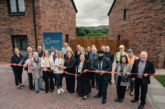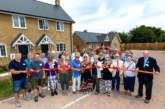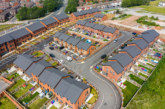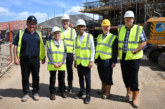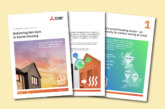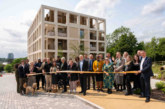EDAROTH (a wholly owned subsidiary of Atkins) has laid bare the extent of the current UK housing crisis in its latest white paper — New Approach, Better Homes, Brighter Future.
The report demonstrates clearly how unlocking dormant brownfield land to develop for affordable homes, could have a dramatic impact on social housing waiting lists across the country.
Analysis of data from the Brownfield Register and the latest available social housing waiting lists, illustrates how capacity for building new homes outstrips the waiting list demand in many parts of England.
And, as Prime Minister Rishi Sunak has re-stated his commitment to building more than one million homes before the next general election, EDAROTH has called for action to unlock brownfield land and promote more effective use of modern methods of construction, as a realistic solution to meeting that demand. Not only would unlocking brownfield sites help create the necessary capacity for social housing, but it would also drastically reduce the cost of keeping people in temporary accommodation.
Currently around 95,000 households are in temporary accommodation which is costing the Government up to £1.6bn. In addition, according to data released in April by the Regulator of Social Housing (RSH) for 2022, affordable rent costs were double the equivalent social rents in some parts of England.
Mark Powell, Managing Director at EDAROTH (an acronym of Everybody Deserves A Roof Over Their Head) said: “The number of people identified as living in temporary accommodation has risen by an alarming 74% in the last 10 years***. Of that total, more than two-thirds had been living in temporary accommodation for more than a year.
“By transitioning households from temporary accommodation into social rented homes, we estimate local authorities across England could save in excess of £1bn. This saving could then be used to offset the delivery of up to 14,000 new social and truly affordable homes each year.
“To beat the social housing emergency, I believe we must drive market reform and speed up planning with a presumption in favour of net zero compliant homes.
“If we do this, we will be able to accelerate the delivery of energy-efficient, truly affordable homes. However if we continue to rely on traditional methods and approaches, I believe the housing crisis will deepen, with low-income households and the most vulnerable in our society feeling the harshest effects.”
The affordable homes developer which uses modern methods of construction (MMC) to create sustainable, thriving places, says that low-income and vulnerable households will remain trapped in unaffordable, insecure and, in some cases, unsafe homes without a new approach in place.
EDAROTH entered the housing market three-years-ago, to help local authorities and the Government address the shortage of social housing. However, according to the new report very little has changed in that time. The Government’s most recent affordable housing statistics show there were 7,500 new social homes delivered in 2021-22.
But with more than one million households currently on social housing waiting lists across England, this build rate falls woefully short of widely-accepted estimates that at least 90,000 new social homes need to be built every year.
How brownfield can meet demand
Unlocking under-utilised brownfield sites, often overlooked by large-scale housebuilders could help local authorities find suitable locations for new social housing.
The data shows that councils across England from Bournemouth to Birmingham, and Norwich to Newcastle, would be able to dramatically reduce housing waiting lists if brownfield sites were developed.
EDAROTH has analysed the potential capacity for homes on brownfield land from the Brownfield Register, and calculated the percentage of social housing waiting lists it could absorb. The results are revelatory as our table below illustrates.
For example in Manchester, the waiting list from 2022 was 14,912, while the estimated number of homes that could be built on brownfield sites stands at 75,585. In Birmingham, the waiting list figure is 21,867, yet there is capacity to build 54,304 homes. And in Bournemouth it’s a similar story with a waiting list of 1,180 which could disappear within the potential 18,036 homes that could be built on brownfield sites.
The overall national percentage impact that brownfield land could have on housing waiting lists is now 109.9%.
| Local authority (England only) | Hectares of brownfield available | Social housing waiting list 2022 | Total minimum net dwellings on brownfield | Impact on waiting lists |
| Bournemouth Christchurch and Poole | 202.1 | 1,180 | 18,036 | 1528.5% |
| Birmingham | 629.6 | 21,867 | 54,304 | 248.3% |
| Manchester | 483.3 | 14,912 | 75,585 | 506.1% |
| Newcastle-upon-Tyne | 185.1 | 6,149 | 10,958 | 173.9% |
| Leeds | 801.6 | 26,241 | 29,527 | 112.1% |
| Nottingham | 194.6 | 8,207 | 11,698 | 142.5% |
| Norwich | 158.6 | 3,906 | 9,184 | 235.1% |
| Lewisham | 110.8 | 10,183 | 12,572 | 123.4% |
| Basingstoke & Dean | 114 | 4,061 | 5,497 | 135.4% |
The white paper report outlines how modern methods of construction can make a significant contribution to solving the housing crisis by providing low energy, affordable and sustainable homes quickly, driving economic regeneration to support the levelling up agenda and meet net zero goals. This is supported by analysis published on behalf of the Local Government Association (LGA), National Federation of ALMOS and Association of Retained Council Housing (ARCH) in September 2021 — estimating that building 100,000 new social homes each year could contribute £15bn to the UK’s economy.
Call to action:
In order to shore up demand and support the MMC sector, the EDAROTH white paper is calling for increased incentives for local authorities, public sector bodies, and housing associations, to vastly increase the supply of social housing at scale, utilising MMC.
EDAROTH believes there is a strong argument for the urgent prioritisation of Government and local authority-owned brownfield land to deliver new homes which demonstrate clear societal and economic value.
It will also be imperative to go further than the current approach of one-for-one replacements of homes sold if social housing demand is to be met, waiting lists reduced and households to be lifted out of temporary accommodation — according to the report.
Mark Powell added: “To beat the social housing emergency, I believe we must harness new ideas and approaches. If we do this, we will be able to accelerate the delivery of energy-efficient, affordable homes.
“To truly unlock the potential of MMC in the housing sector, we must create the right market conditions for the industry to flourish and grow. This represents a very real opportunity to provide the energy efficient net zero homes that people want and need, located in the communities where they want to live and thrive.
“These are homes that provide sustainable jobs, and that boost local economies. Homes that reduce inequalities, and help to rebalance the economy — in lockstep with the Government’s levelling-up and net zero agendas.
“But we must not underestimate the challenge ahead. It will take collaboration, commitment and surety if MMC companies are to grow to meet the demand for new homes.”
*Based on the total number of households in temporary accommodation and associated expenditure 2021/22
**EDAROTH white paper – New Approach, Better Homes, Brighter Future.
***According to research from Shelter published January 2023



